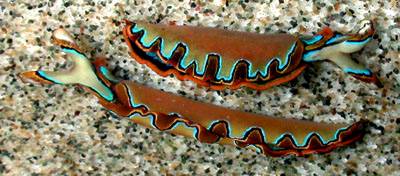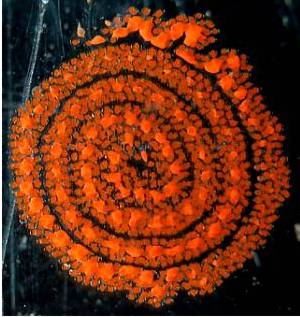Egg masses of Thuridilla neona (1)
April 23, 2003
From: Cory Pittman

Dear Bill,
Following on the discussion concerning the egg ribbon of Elysia maoria here is soem information on Thuridilla neona. It is a common, diurnal species in shallow Maui waters and is another example of an elysiid that produces prominent granules of “extra-capsular yolk”. In this case, the granules appear to be centrally (or ventrally?)located along the axis of the ribbon as indicated by the presence of eggs on top of some of them in the close-ups.
The animals in the first photo were collected on Dec. 1, 2002 at Hekili Point, Maui at a depth of one or two meters. Their lengths were 10 mm and 12 mm. I held them in a dish for several days and both laid eggs. The two photos in this message show the masses a few hours after laying. The loosely coiled mass measured 6.4 mm by 5.5 mm. The tightly coiled mass was 2.9 mm in diameter. The ribbons in both were about 0.4 mm thick and nearly cylindrical in cross section.
In a separate message there are three close-ups of a portion of the loosely coiled ribbon taken, respectively, a few hours after laying, about two days later and about five days later. The eggs gradually lost their orange pigment as they developed while the granules remained largely unchanged. Hatching occurred after about six days. The larvae, on hatching, were transparent and the granules remained visible in the ribbon after they hatched.
I hope this will be of interest.
Best wishes,
Cory
norm@maui.net


Thanks very much Cory,
These are fascinating observations. It looks as though the photos of the egg ribbon of Elysia vatae on the Forum are very similar to what we see here in T. neona. From your close-ups in the separate message, it certainly appears that the embryos surround the yolk 'blobs' and so have access to them, which seems to be quite different from the case of Elysia maoria. However from your observations and close-ups it doesn't seem the embryos [developing larvae] utilise the 'yolk' at all. Which makes me wonder what its there for at all. All the 'yolk blobs' in E. maoria are postitioned differently, there is a great similarity. If they are not food reserves for the developing larvae, perhaps they are decoys? If I am allowed the luxury of wild speculation, perhaps they are full of antifeedant chemicals and are decoy eggs to attract and discourage potential predators.
Best wishes,
Bill Rudman
Related messages
-
Thuridilla neona from sthn Queensland
From: Gary Cobb, February 6, 2009 -
Re: Elysia colors
From: Skip Pierce, November 2, 2005 -
Thuridilla neona and colour patterns
From: Skip Pierce, October 31, 2005 -
Thuridilla neona from Lizard Island
From: Ingo Burghardt, October 31, 2005 -
Re: Thuridilla cf. neona? from Great Barrier Reef
From: Julie Marshall, October 28, 2005 -
Thuridilla cf. neona? from Great Barrier Reef
From: Daniel Foote, October 26, 2005 -
Thuridilla neona? off Townsville, QLD
From: Daniel J. Foote, October 8, 2005 -
Egg masses of Thuridilla neona (2)
From: Cory Pittman, April 23, 2003
